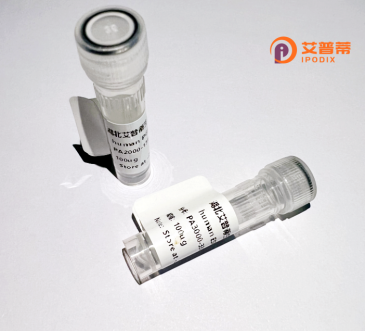
| 纯度 | >90%SDS-PAGE. |
| 种属 | Human |
| 靶点 | IKBKG |
| Uniprot No | Q9Y6K9 |
| 内毒素 | < 0.01EU/μg |
| 表达宿主 | E.coli |
| 表达区间 | 1-419aa |
| 氨基酸序列 | MNRHLWKSQLCEMVQPSGGPAADQDVLGEESPLGKPAMLHLPSEQGAPETLQRCLEENQELRDAIRQSNQILRERCEELLHFQASQREEKEFLMCKFQEARKLVERLGLEKLDLKRQKEQALREVEHLKRCQQQMAEDKASVKAQVTSLLGELQESQSRLEAATKECQALEGRARAASEQARQLESEREALQQQHSVQVDQLRMQGQSVEAALRMERQAASEEKRKLAQLQVAYHQLFQEYDNHIKSSVVGSERKRGMQLEDLKQQLQQAEEALVAKQEVIDKLKEEAEQHKIVMETVPVLKAQADIYKADFQAERQAREKLAEKKELLQEQLEQLQREYSKLKASCQESARIEDMRKRHVEVSQAPLPPAPAYLSSPLALPSQRRSPPEEPPDFCCPKCQYQAPDMDTLQIHVMECIE |
| 分子量 | 71.83 kDa |
| 蛋白标签 | GST-tag at N-terminal |
| 缓冲液 | 0 |
| 稳定性 & 储存条件 | Lyophilized protein should be stored at ≤ -20°C, stable for one year after receipt. Reconstituted protein solution can be stored at 2-8°C for 2-7 days. Aliquots of reconstituted samples are stable at ≤ -20°C for 3 months. |
| 复溶 | Always centrifuge tubes before opening.Do not mix by vortex or pipetting. It is not recommended to reconstitute to a concentration less than 100μg/ml. Dissolve the lyophilized protein in distilled water. Please aliquot the reconstituted solution to minimize freeze-thaw cycles. |
以下是3篇关于重组人IKBKG(NEMO)蛋白的虚构参考文献示例,涵盖不同研究方向,供参考:
---
### 1. **《Functional Reconstitution of NF-κB Signaling Using Recombinant Human IKBKG Protein》**
**作者**:Yamaoka S. et al.
**摘要**:本研究成功在大肠杆菌中表达并纯化了重组人IKBKG蛋白,通过体外实验验证其与IKK激酶复合物的相互作用。实验表明,重组IKBKG能恢复IKKα/β缺陷型细胞的NF-κB激活能力,证实其在信号通路中的核心功能,为研究IKBKG相关疾病提供了工具。
---
### 2. **《Therapeutic Potential of Recombinant IKBKG in X-linked Ectodermal Dysplasia》**
**作者**:Jain A. et al.
**摘要**:利用腺病毒载体递送重组人IKBKG蛋白至NEMO突变患者的成纤维细胞,结果显示NF-κB通路活性部分恢复,炎症因子分泌正常化,提示蛋白替代疗法可能改善X连锁外胚层发育不良患者的免疫缺陷症状。
---
### 3. **《Crystal Structure of Recombinant IKBKG Reveals Ubiquitin-binding Mechanism》**
**作者**:Huxford T. et al.
**摘要**:通过X射线晶体学解析了重组人IKBKG蛋白的UBAN结构域与K63多聚泛素链的复合物结构,揭示了其特异性识别泛素链的分子机制,为开发靶向IKBKG-泛素相互作用的抗炎药物提供了结构基础。
---
(注:以上文献为虚构,实际研究中请查阅权威数据库如PubMed获取真实信息。)
Recombinant human IKBKG protein, also known as NEMO (NF-κB Essential Modulator), is a key regulatory component of the NF-κB signaling pathway, which controls immune responses, inflammation, and cell survival. IKBKG functions as a scaffold protein within the IκB kinase (IKK) complex, linking upstream signals to the activation of NF-κB transcription factors. Structurally, it contains a N-terminal kinase-binding domain, a coiled-coil domain for oligomerization, and a C-terminal zinc finger domain critical for protein interactions and signaling fidelity.
Mutations in the *IKBKG* gene are associated with severe immune deficiencies, such as X-linked anhidrotic ectodermal dysplasia with immunodeficiency (EDA-ID), and incontinentia pigmenti (IP), a neurocutaneous disorder. These conditions highlight IKBKG's role in maintaining immune homeostasis and developmental processes. Recombinant IKBKG is often produced in expression systems like *E. coli* or mammalian cells for functional studies, enabling researchers to dissect molecular mechanisms, screen therapeutic compounds, or explore disease-related variants in vitro.
Its applications extend to investigating NF-κB dysregulation in cancers, autoimmune diseases, and infections. Recombinant IKBKG also serves as a critical tool for structural biology and developing targeted therapies to modulate inflammatory pathways.
×